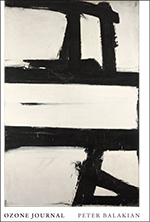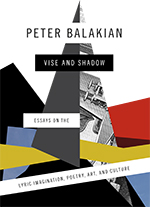Book Review
In both Vise and Shadow and Ozone Journal, Peter Balakian explores the relationship between the lyric and larger social movements, envisioning poetry as “aesthetic imagination [that] shadows history, shadows human experience, casts its own kind of illumination, often unromantic, sober, shadow-like in its truths.” Balakian’s description of poetry’s truths as “shadow-like” is perhaps most revealing, evoking both subtlety and dissimulation. Indeed, his interest lies not as much in the narrative capacity of the lyric, but rather, in the ways that history, its discontents, and its ruptures manifest in the behavior of the language itself. As Balakian explores the myriad ways that understated stylistic choices can be politically charged, he draws from a vast repertoire of literary and artistic influences, which range from Bob Dylan to Primo Levi, Dante, Hart Crane, and Arshile Gorky. For Balakian, these texts are all, in their own way, symptomatic of larger social upheavals, embodying and enacting on the smallest scale, the ghostly presence of history within modernity. With that in mind, the release of Vise and Shadow and Ozone Journal in close proximity proves to be especially well-timed, as Balakian’s poetry and criticism both offer something fundamentally different, and equally necessary, as a vehicle for response.
Although dealing with an array of texts and historical periods, Vise and Shadow is elegantly unified by Balakian’s unique approach to criticism. Treating each work of art as a deconstruction, a response through form, sound, and wild associative leaps to the various artistic and cultural texts that came before, Balakian’s terms are simultaneously his own and utterly dependent upon the work in question. What this approach makes possible is a proliferation of meaning within the seemingly small space of a line break, a simple refrain, or the apparent distance between two disparate images.
“Ingesting Violence: The Poetry of Witness Problem” exemplifies these ideas with subtlety and grace. In this piece, which focuses on Carolyn Forché’s groundbreaking anthology Against Forgetting: Twentieth-Century Poetry of Witness, Balakian addresses “the misunderstanding and confusion surrounding the concept, idea, and rhetoric of what ‘witness’ might mean, and what poets have achieved with their various lyric forms and language strategies in the realm of representing certain kinds of violent experiences.” Although documenting what the concept of ‘witness’ has become in the public imagination through personal correspondence, as well as texts that circulated within the literary community, Balakian’s essay is at its best when the poems themselves are set in sharp relief against a public discourse that remains hostile to them. He elaborates in his discussion of poetry from Forché’s anthology:
Czeslaw Milosz’s “Dedication” is a meditation on aftermath, and the coda, “Warsaw, 1945,” situates us in time and place—at the end of World War II; after enormous ruin, Milosz wrestles with what poetry might be or mean […] He makes ideas, often complex ones, into lyrical language, with elegant rhythms; and here he engages history’s paradoxes: “What strengthened me, for you was lethal. / You mixed up farewell to an epoch with the beginning of a new one.” In the ruins of aftermath, traumatic memory is like a clear aerial-like view of a landscape […]
What’s interesting about Balakian’s reading of Milosz is his ability to look past the narrative and reveal the philosophical underpinnings of the poet’s smallest choices. For example, he reads Milosz’s use of caesura and juxtaposition (particularly in lines like “What strengthened me, for you was lethal”) as a meditation on “history’s paradoxes,” allowing the subject’s experience to serve as a point of entry to more universal questions. Balakian presents Milosz’s technical deftness (particularly his lyricism) as documenting trauma, its aftermath, and the sudden clarity that saying “farewell to an epoch” can bring; a reading thought-provoking in both its specificity and its expansiveness. Vise and Shadow is filled with carefully crafted essays like this one, which allow sentence-level innovations to become a doorway to ambitious philosophical and ethical questions.
When considering Ozone Journal, it becomes clear that Balakian privileges many of the same linguistic strategies in his own poetry that he values as a reader and cultural critic. Additionally, the collection reads as an artistic engagement with many of the same texts that interested him when writing Vise and Shadow. While many similar concerns manifest across genres and textual boundaries, what distinguishes Ozone Journal is the prominent role that silence plays in conveying the memories of trauma, and the sense of mourning that remain indelibly inscribed in the contemporary cultural imagination. Consider “Pueblo 2, New Mexico”:
The Chief said, you can’t see what’s beyond the mountain,
as I watched the blue shimmer-light rise
over the tables of silver and turquoise on the square.
(Plato said the soul is in balance when reason
slices appetite into a wing.)
The Chief was a woman guide, a leather-worn
native who lived without running water to live here.
Balakian’s movement from the “tables of silver and turquoise on the square” to Plato’s writings on the soul and back to “The Chief” is revealing for several reasons. By situating the discussion of Plato in a new stanza, isolated from the scenes portraying the “woman guide” and the natural world, he suggests the distance between so much of Western thought and the realities of “a leather-worn / native who lived without running water to live here.” Indeed, the speaker implicates himself as privileged, and form conveys the many ways that privilege can isolate one from much of modernity, rendering empathy and understanding increasingly difficult ideals to attain. Even more important, the white space between stanzas conveys a sense of loss inherent in this distance between the speaker and what he is beholding—the respectful and reverent silence when language inevitably fails. Like much of the work in Ozone Journal, “Pueblo 2, New Mexico” offers stunning and subtle technical maneuvers, Balakian’s formal choices proving to be as meaningful as the philosophical musings that take place.
With that said, silence takes different forms, and resonates in many ways as the book unfolds. Ranging from brief pauses within a piece, which gesture at the ineffable, to cavernous spaces between characters in a narrative, the white space in Balakian’s poems proves to be as carefully orchestrated as the words themselves. In “Warhol/Mao, ’72,” for example, the ruptures between lines and stanzas convey distance, which is rarely conceptualized in terms of geographic space. Here, Balakian uses white space to evoke the irreconcilability of ideologies and worldviews:
When I saw his face on a wall
at a party in a parlor looking out on the Hudson,
at a fundraiser for the winter soldiers
over blocks of cheese and baguettes,
I had just come from some grainy footage
of Dien Bien Phu in a hot black room,
where the scratched print showed the hills undulating,
bodies and parachutes disappearing in jungle grass.
Between decadence and the alien […]
What’s perhaps most interesting is the way that Balakian moves between lines and stanzas. The first enjambment seems to link the rise of industry and the emergence of communist regimes, presenting Mao’s “face on a wall” with the pristine view of the natural world as entirely separate. In ways, the line break evokes the ideological distance between east and west, suggesting the incommensurability of capitalist societies and everything that portrait represents. Later stanzas utilize line breaks and stanza breaks in similar ways, conveying the vast ideological distance between the “decadence” of the west and ongoing political unrest in the east, and the inevitable disconnect between reality and representation. By breaking the line after “grainy footage,” for example, Balakian reminds us of the divide between subject and object, viewer and viewed. These subtle technical choices make the work even richer, complimenting and complicating the content.
In other words, Balakian’s poetry allows silence to accumulate meaning, prompting the reader to consider just how many conflicts, and how much tension, a single brief pause can sustain. While this fascination with silence, and what must be left unspoken, frequently surfaces in Balakian’s discussions of literature in Vise and Shadow, the effect is vastly different across genres. His critical essays show us history as text, and text as history, and it is the form of essay that allows Balakian to call our attention to the silences and ruptures within history itself, to examine the tension, violence, and conflict that they embody. His discussion of Eliot’s The Waste Land in his essay, “Collage and Its Discontents,” engages these ideas:
The opening section, “The Burial of the Dead,” can be seen as a series of intersecting cubist-planes that move without ligatures or narrative rationales. In five scenes and five voices, we move seamlessly from the elegiac opening of April as the cruelest month (a riff on Chaucer) to the spoken voice of the young girl, Marie, who recalls the privileged life of her Central European childhood in the Starnbergersee Mountains of Bavaria. Her nostalgic, prewar memory of staying at the archduke’s and sledding in the carefree mountains is deepened by lines of German that inscribe her cultural identity.
I’m fascinated by Balakian’s analysis of these unexpected textual juxtapositions, which pair vastly different landscapes, temporal moments, and languages. For Balakian, the way that the poem drifts between languages suggests the incommensurability of not only meaning, but cultural identities and narratives of history. Balakian suggests that it is the moment when the text becomes inaccessible to an English language reader, for example, that he or she truly understands the distance between not only geographic spaces, but worldviews, experiences, and historical vantage points. Vise and Shadow is filled with insightful essays that situate familiar texts within larger historical and cultural landscapes, prompting us to treat history as one would a literary text.
With that in mind, Ozone Journal and Vise and Shadow are as complimentary as they are vastly different in genre and artistic resources. Although one might think of Vise and Shadow as a statement of aesthetic values, the poetry collection being merely an enactment of these ideals, the relationship between the two texts proves to be much more nuanced than that. While Balakian’s essays reveal the ways history and its discontents inscribe themselves in the smallest features of familiar texts, his poems offer a mournful silence in the face of these social upheavals, and their aftermath, that is only possible within the realm of art. Readers will find both texts equally necessary and equally moving.
About the Reviewer
Kristina Marie Darling is the author of over twenty collections of poetry and hybrid prose. Her awards include fellowships from Yaddo, the Ucross Foundation, the Helene Wurltizer Foundation, and the American Academy in Rome, as well as grants from the Kittredge Fund, the Elizabeth George Foundation, the Ora Lerman Trust, and the Rockefeller Foundation Archive Center. She is currently working toward both a Ph.D. in English Literature at S.U.N.Y.-Buffalo and an M.F.A. in Poetry at New York University.

